Crassula ovata Druce 1917
Syn. C. argentea, C. portulaca, C. obliqua
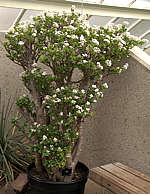
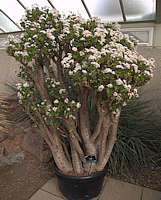
Above: Large Crassula ovata plants at RBG Kew
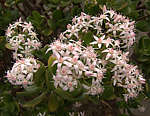
Crassula ovata flowers
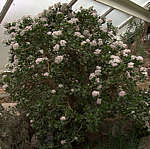
Large Crassula portulaca
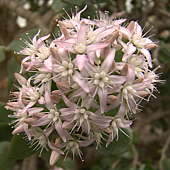
Crassula portulaca flowers. Individual florets 5 mm
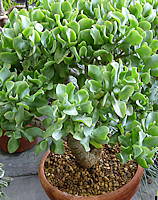
Crassula ovata cv. "Blue Surprise"
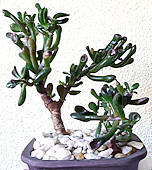
Crasula ovata cv. Gollum
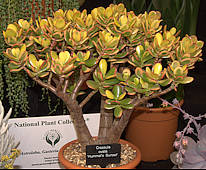
Crassula ovata cv. "Hummel's Sunset"
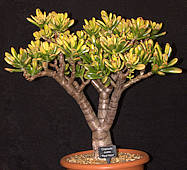
Crassula ovata cv. "Red Horn"
|
A number of rather similar, large shrub-like succulent Crassulas are widely grown as house plants with common names of Jade Plant/Tree, Money Plant, Dollar Plant/Tree. All are varieties of Crassula ovata which is synonymous with several older names listed above. Jade plants are popular because they are incredibly easy to grow. With proper care and time they make fine specimens not unlike bonsai trees. (See right)
However, I receive many queries related to Jade and Money Plants which are not growing well.
The commonest problem is probably overwatering, sometimes coupled with a dark location on top of a filing cabinet or kitchen cupboard. In order to grow these Crassulas really well,
one should remember their natural habitat on dry hillsides under the blazing South African sun. Rain there is infrequent and usually occurs during the winter months, which are generally much warmer than ours. Consequently, Jade plants flower during the late winter and behave in the same way in the Northern hemisphere. The flowers have a faint perfume like scented soap.
Location
A Jade plant needs very bright light to grow well and a sunny position if it is to flower. At the same time, good air circulation will help to avoid scorch on hot days and excessive humidity in cold wet weather. A plant should not be moved suddenly from a shady position into full sunshine, but needs to be acclimatised slowly, or damage to the leaves is likely. If this happens, the leaves will be dropped and replaced in time, so the damage is not permanent.
Jade plants grow well outside as patio plants during the summer and their leaves will colour up in the sun, but remember to bring them indoors before the first frosts. The plant will stop growing at temperatures much above 90°F. Jade plants will survive cold conditions to just above freezing if the soil is kept dry but must be kept frost free at all times. Cold night temperatures may help to promote flowering. (See right) However, some cultivars never seem to flower.
Watering
It is best to water thoroughly and then let the plant dry out between waterings. The plant needs water when its lower leaves become soft and in an extreme case become wrinkled. When water is given, these leaves will plump up again, a sign that all is well with the roots. Do not keep the soil moist all the time. Water from the base by standing the plant pot in a dish of water, but never leave the plant standing in water for more than a few hours. Then always pour away any excess water that has not been taken up into the soil.
A few leaves drop off naturally, especially when it is hot or if the plant is kept dry for a long time. If the leaves wrinkle or drop off excessively despite provision of water, something is wrong with uptake of water into the plant. Do not immediately assume that the plant wants more water if you have been watering it regularly. If the roots are not taking up water, then adding more will lead to soggy compost and cause more problems. Check the roots, if necessary by removing the plant from its pot. This operation will do no harm if carried out carefully.
Examine the roots of the un-potted plant for sign of pests such as root mealy bug. Look for rotten roots and soft rotten areas at the base of the stem, which can be caused by soggy conditions and which stop effective water uptake. If the bottom of the stem has gone soft, remove the plant from its pot and allow it to dry off. Then assess the condition of the stem. In emergency, it is possible to salvage the plant by re-rooting the healthy part. Cut the stem well above the damaged area. Allow the cut end to dry off for a couple of weeks and then re-plant into a dry, free-draining potting mix. Water very sparingly until root formation has started.
It's not necessary to mist or spray water over the foliage, and excessive humidity may lead to mildews and other fungal problems. Spraying with water may also remove the attractive surface bloom from the leaves of some cultivars. However, putting the plant outside occasionally in the rain on a mild day, helps to wash off dust and freshen up the foliage.
Soil and fertiliser
A Jade plant can not be expected to grow well in the same soil for many years. Frequent re-potting into new soil and a slightly larger pot will help the plant to grow well. The soil mixture is not critical and any general houseplant compost is fine. However, a free-draining mixture with the addition of up to a third by volume of added grit and/or sharp sand is preferred. My personal preference is to avoid peat-based composts as these seem to encourage pests such as root mealy bug.
To maintain a plant at about the same size, treat in a similar way to a bonsai tree. Prune the roots when re-potting into the same size pot and cut back the stems to maintain a pleasing shape. This will help to develop a thick main trunk. Prune back to just above the rings on the stems where the old leaves were located. New leaves will grow from these locations. Do not be afraid to cut back the growth. Providing the plant has a well-developed main stem, it is possible to prune back weak growth until there are no leaves left. New ones will grow at the cut ends after a few weeks. However, such severe pruning should not be carried out too often !
Fertiliser at about one-quarter the recommended strength should be given with every watering during the growing period. A low nitrogen formulation helps to avoid "leggy" growth.
Pests & diseases - More about pests & diseases
Keep your plant clean and pull off and discard old leaves. Remove any dead leaves that have dropped off, from the surface of the soil as these may provide hiding places for pests.
Examine suspect leaves with a high power (10x) magnifying glass as some pests like red spider are too small for the insect to be seen with the naked eye. Don't confuse normal leaf markings of tiny white or red dots with pests. Some species have natural powdery coatings on the leaves which need to be distinguished from e.g. red spider webbing. White fluffy deposits on the roots or stems usually indicate infestation with mealybugs.
Crassulas can be treated with most systemic insecticides, but do not use Malathion or other pyrethrin-based sprays. Avoid spraying Crassulaceae with powdery blooms on the leaves, which would be marked. It is best to take a house-plant outside to spray it and the skin should be protected with gloves, face mask etc. Watering with a systemic insecticide based on imidacloprid should keep your plant pest-free for months and avoid the problems of spraying. I have never seen a Crassula show a bad reaction to Imidacloprid. However, this is now unavailable in the UK and has been replaced by newer neonicotinoids.
Propagation
Jade plants can be propagated from a single healthy leaf. Place the leaf leaning aginst the side of the pot with its base just touching the top of the soil. Don't water until you see that the leaf is producing roots and a new plant is forming. This takes some time.
Jade plants can be produced more rapidly from stem cutings, which can be quite short. For safety, allow the cut end to dry off for a couple of weeks and then pot up in dry-ish soil. After two or three weeks a little water can be given. In my experience, no harm comes to a Jade plant cutting pushed straight into wet soil and left out in the Summer rain.
|

 Families of Succulent Plants
Families of Succulent Plants Crassulaceae
Crassulaceae 


 Families of Succulent Plants
Families of Succulent Plants Crassulaceae
Crassulaceae 
